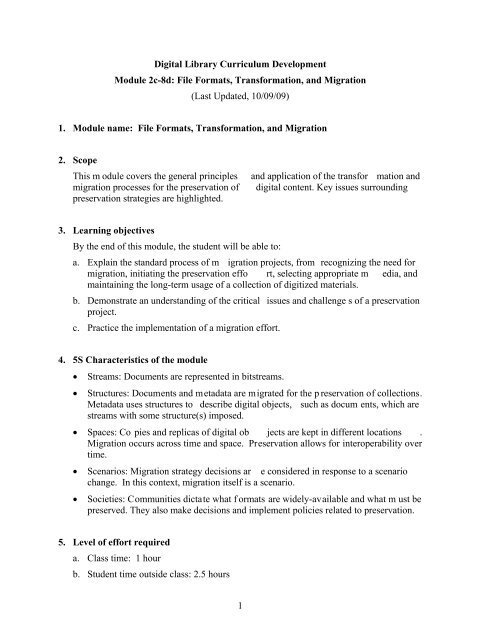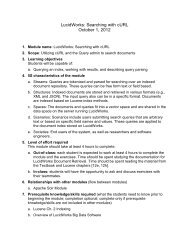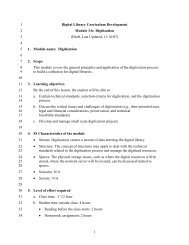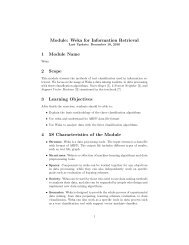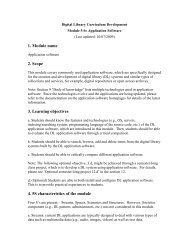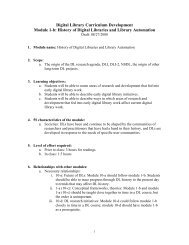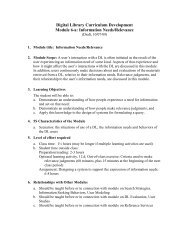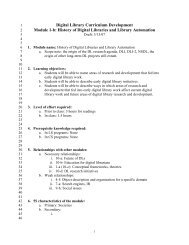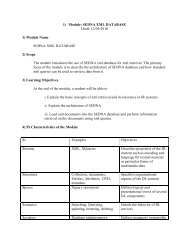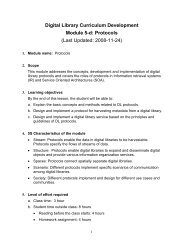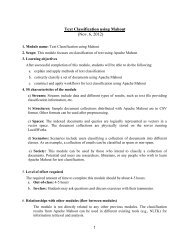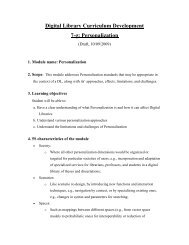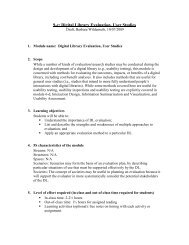File Formats, Transformation, and Migration - Digital Library ...
File Formats, Transformation, and Migration - Digital Library ...
File Formats, Transformation, and Migration - Digital Library ...
- No tags were found...
Create successful ePaper yourself
Turn your PDF publications into a flip-book with our unique Google optimized e-Paper software.
<strong>Digital</strong> <strong>Library</strong> Curriculum DevelopmentModule 2c-8d: <strong>File</strong> <strong>Formats</strong>, <strong>Transformation</strong>, <strong>and</strong> <strong>Migration</strong>(Last Updated, 10/09/09)1. Module name: <strong>File</strong> <strong>Formats</strong>, <strong>Transformation</strong>, <strong>and</strong> <strong>Migration</strong>2. ScopeThis m odule covers the general principles <strong>and</strong> application of the transfor mation <strong>and</strong>migration processes for the preservation of digital content. Key issues surroundingpreservation strategies are highlighted.3. Learning objectivesBy the end of this module, the student will be able to:a. Explain the st<strong>and</strong>ard process of m igration projects, from recognizing the need formigration, initiating the preservation effo rt, selecting appropriate m edia, <strong>and</strong>maintaining the long-term usage of a collection of digitized materials.b. Demonstrate an underst<strong>and</strong>ing of the critical issues <strong>and</strong> challenge s of a preservationproject.c. Practice the implementation of a migration effort.4. 5S Characteristics of the module• Streams: Documents are represented in bitstreams.• Structures: Documents <strong>and</strong> metadata are migrated for the p reservation of collections.Metadata uses structures to describe digital objects, such as docum ents, which arestreams with some structure(s) imposed.• Spaces: Co pies <strong>and</strong> replicas of digital ob jects are kept in different locations .<strong>Migration</strong> occurs across time <strong>and</strong> space. Preservation allows for interoperability overtime.• Scenarios: <strong>Migration</strong> strategy decisions ar e considered in response to a scenariochange. In this context, migration itself is a scenario.• Societies: Communities dictate what f ormats are widely-available <strong>and</strong> what m ust bepreserved. They also make decisions <strong>and</strong> implement policies related to preservation.5. Level of effort requireda. Class time: 1 hourb. Student time outside class: 2.5 hours1
• Reading before the class starts: 2 hours• Homework assignment: 0.5 hours6. Relationships with other modules• 2-a: Text Resources, 2-b: Multimedia2-a <strong>and</strong> 2-b cover the nature, structure, co mposing factors, <strong>and</strong> for mats of varioustypes of digital objects (e.g., text, images, video, etc.).• 3-b: Digitization3-b covers the process of digitiza tion rega rdless of the object type s, a nd discusse sdigital file formats.• 4-b: Metadata, cataloging, metadata mark-up, metadata harvesting4-b covers uses of m etadata <strong>and</strong> metadata st<strong>and</strong>ards related to the context of digitallibraries in general.• 8-a: Preservation8-a covers the related technology, st<strong>and</strong>ards, <strong>and</strong> policies concerning the preservationof digital objects.7. Prerequisite knowledge required: None8. Introductory remedial instruction: None9. Body of knowledge1. Definitions of key termsa. <strong>File</strong> <strong>Formats</strong>i. A file format refers to th e layout of the data in side of the file <strong>and</strong> th eorganization of that data in terms of bits, since digital data can only bestored using a binary system in terms of 0s <strong>and</strong> 1s.ii. Packages of information can be s tored as da ta files or transmitted asdata streams (a.k.a. bitstreams or byte streams)iii. A format is a fixed, byte-serialized encoding of an information modelb. <strong>File</strong>name Extensionsi. Extensions are suffixes to the f ilename, which give an indication as tothe format of the content of the file.2
ii. <strong>File</strong>name extensions have histor ically been a 3 character suffix.However, modern operating system s don’t have such lim itationsanymore.iii. Reference: http://www.file-extension.comc. Bitstream Copyingi. Copying a stream of data into a duplicate stream.ii. It is commonly known as “backing up” your data.iii. Bitstream copying refers to the pr ocess of m aking an exact duplicateof a digital object.d. <strong>Transformation</strong>e. <strong>Migration</strong>i. <strong>Transformation</strong> is the process of altering the for mat of an object(destination format could be a digital file or output display).ii. <strong>Transformation</strong> m eans that a file is converted from one fi le form at(e.g., .avi) to another file format (e.g., .mov).i. “Transfer of a data object, as from on e format to another, or from onemedium to another, or between instances of the same type of storagemedium” (Rosenthal et al., 2005)ii. <strong>Migration</strong> refers to the move ment of data from one m edia technologyto another.iii. Switching from storing digital data in CDs to storing it in hard disksmeans migration from the CD to hard disks as media of storage.f. Refreshing – copying content to new media periodicallyi. Refreshing is to copy digital info rmation from one long-term storagemedium to another of the same type, with no change whatsoever in thebitstream (e.g., from an older CD -RW to a new CD-RW ). New mediais of the same type as the old media. You copy data from an old CD toa new CD.ii. The goal of refreshing is to preserve the data from any bad effects thatcan be caused by damage to the media that hold the data.iii. Refreshing is key to the preservation of data.g. Modified Refreshing2. <strong>File</strong> <strong>Formats</strong>i. Modified refreshing is the copying to another m edium of a sim ilarenough type that no change is made in the bit-pattern that is of concernto the application <strong>and</strong> operating system using the data.ii. For instance, you may copy from a 100 MB Zip disk to a 750 MB Zipdisk.3
a. To preserve documents, a collection’s file format must ensure the following:i. Save the bits so that som ewhere a copy survives <strong>and</strong> that copy can befound.ii. Ensure that the bits can be interpreted later (file format retention).iii. Make the bits trustworthy by reliably associating sufficient metadata.iv. Include library content lists among the set of saved documents.v. Minimize the need for digital archeology (rescuing content fromobsolete technology) through the ability to translate to other formats.b. Which for mats can preserve content or lead to a longer duration betweentransformations?i. International st<strong>and</strong>ards are preferred.ii. XML allows users to underst<strong>and</strong> an object’s structure <strong>and</strong> contentwithout using specific machines or software.iii. Text docum ents ( Word or other proprietary for mats) depend oncompatibility between software versions. XML with metadata taggingwould lead to longer preservation.iv. PDF documents lead to PDF/A documents (archiving).v. Image options – TIFF, GIF, JPEG, JP2, Flashpix, Im agePac, PNG,PDFc. Sustainability factors for file formatsi. Adoption – used by the prim ary creators, dissem inators, or users ofinformation resourcesii. Disclosure – complete specifications <strong>and</strong> tools for validating technicalintegrity exist <strong>and</strong> are accessibleiii. External Dependencies – depends onsystem, or softwareparticular hardware, operatingiv. Impact of Patents – ability of archival institutions to sustain content ina format will be inhibited by patentsv. Quality <strong>and</strong> f unctionality – ab ility of a f ormat to rep resent thesignificant characteristics of a gi ven content item required by current<strong>and</strong> future usersvi. Self-documentation – contains basic descriptive, tec hnical, <strong>and</strong> otheradministrative metadatavii. Transparency – dig ital represen tation is op en to dire ct analysis withbasic toolsviii. Technical Protection M echanism – implementation of m echanisms,such as encryption, that prevent the preservation of content by atrusted repository4
d. <strong>File</strong> format selection is a first step in long-term preservation measures that ispart of a larger information management strategy.Figure 1: Relationships between digital preservation <strong>and</strong> managementTaken from: http://home.pacbell.net/hgladney/ddq_1_2.htm3. Emulatione. Difficult items to store or move between formatsi. mathematical symbolsii. chemical formulasiii. archaic scripts or ideographs, such as Egyptian or Mayan hieroglyphsiv. musical notationsa. “The essential idea behind emulation is to be able to access or run originaldata/software on a new/current pla tform, by running software on thenew/current platform that emulates the original platform.”(Granger, 2000)b. The digita l object is ke pt in its o riginal f ile f ormat; the hardware a nd/orsoftware needed to render that format are emulated.c. Advantages <strong>and</strong> Disadvantagesi. Emulation may retain the "look <strong>and</strong> f eel, <strong>and</strong> interactivity" of a digitalobject.ii. Emulation avoids information loss.iii. Emulation requires full knowledge of the original system <strong>and</strong> context.iv. Emulation software needs to be upgraded to work with currentsystems.d. Technical Issues5
i. How many layers of emulation?ii. Are there st<strong>and</strong>ards <strong>and</strong> open speci fications that can facilitateemulation?e. Legal issuesi. proprietary systemsii. reverse engineering4. <strong>Transformation</strong> <strong>and</strong> <strong>Migration</strong>a. <strong>Migration</strong> is a fundamental digital preservation strategy.b. Goalsi. Preserve content <strong>and</strong> functionality of a digital object.ii. Ensure continued access to the digital object.iii. Minimize physical <strong>and</strong> intellectual information loss.c. Possible Approaches / Strategies to <strong>Migration</strong> (Hedstrom)i. Transfer to paper or microfilm store in "software-independent" format.ii. Retain in the native software environment.iii. Migrate to a system that is compliant with open st<strong>and</strong>ards.iv. Store in more than one format.v. Create surrogates.vi. Save the software needed for access <strong>and</strong> retrieval (see Em ulationsection).vii. Develop software <strong>and</strong> hardware emulators (see Emulation section).d. Types of <strong>Migration</strong>i. To a newer version of the file formatii. To a different file format1. To a st<strong>and</strong>ard file format (Normalization)iii. To a different hardware/software environmente. Frequency of <strong>Migration</strong>i. Automated1. <strong>Migration</strong>s are h<strong>and</strong>l ed by the system , w ithout interventionfrom the content creators or system administrators.ii.On Request1. A content creator or administrator initiates a migration.2. (May also apply to when a DL stores all d igital obje cts in a"master" file format <strong>and</strong> converts them to other formats only atthe request of an end user.)f. Issues with <strong>Migration</strong>i. Conflicting goals for a particular mi gration (e.g., better access, betterpreservation)ii.iii.Is there value in holding multiple versions of a work?Tradeoffs between inform ation loss <strong>and</strong> reduced com plexity <strong>and</strong> costof operation6
Figure 2: Media Comparisonhttp://clir.org/pubs/reports/conway2/index.htmlg. Example object lifecycle (see Figure 3)i. Content exists as an "information package", which contains the contentobject, in analog or digital form, <strong>and</strong> perhaps metadata.ii. <strong>Transformation</strong> occurs to digitize the object to an archival master.iii. An archival master digital object exists.iv. <strong>Migration</strong> action on a digital object changes the master object to createa derivative object.v. The archival m aster is m igrated to new for mats throughtransformations.Figure 3: View of an object undergoing three transformations <strong>and</strong> multiple migrationshttp://www.dlib.org/dlib/june05/jantz/06jantz.htmlh. The OAIS Reference Model provides (among other things) a detailedframework for defining transform ation <strong>and</strong> m igration functions in a digitallibrary system.5. Emulation versus migration7
i. Selection of a file type depends on whether the system used to managethe conten t will be emulated, or if file typ e will be converted tosomething else at a later timeii. Trade-off between the speed of pro cessing, cost of the emulating ormigration software, <strong>and</strong> the accuracy <strong>and</strong> quality of contentiii. Vision6. Preservation Issues1. automatically h<strong>and</strong>le content from creation to preservation2. a self m anaged system that tak es care of em ulation <strong>and</strong>migration3. abstract the preservation processiv. Universal Virtual Computera. Preservation requires1. middle of the emulation vs. migration spectrum2. “It uses elements of both migration <strong>and</strong> emulation whichallows digital objects to be reconstituted in their original form.The UVC concept cons ists of the UVC itself, a logical d atascheme with type descript ion, the UVC pr ogram (formatdecoder) <strong>and</strong> the logical data viewer.” (PADI, UniversalVirtual Computer Papers.)i. Protection of an original itemii. Preserve the technology us ed to digitize the m aterial, <strong>and</strong> the softwareneeded to retrieve <strong>and</strong> render these digital objects. This is an overhead.iii. <strong>Digital</strong> archives must support the new file formats.iv. Maintenance of digital objects from digit corruption or destruction.Who will take the responsibility for long-term preservation?v. Best practices to p reserve formatting so that the context is not los t tofuture generationsvi. Will the digital archives be accessible perpetually in future?8
vii. Quality of digitization – will it st<strong>and</strong> the test of time?viii. <strong>Digital</strong> Objects would be a backup or the original materials will be theones to be preserved?ix. Single or Multiple repositories?x. How much to preserv e? W hich m aterial gets top prior ity to bedigitized <strong>and</strong> preserved?xi. Is it lega lly perm issible f or a libra ry to res can origina ls to replac eunusable <strong>and</strong> corrupted digital objects?xii. What are the copyright im plications of transform ing a digital objectfrom TIFF to JPEG?b. The ICA Guide to Managing Electronic Records sets out seven criteria forselecting media used for preserving digital records:i. Open st<strong>and</strong>ards for digital recording on the mediumii. Robust methods for preventing, detecting, <strong>and</strong> reporting errorsiii. Sufficient market penetrationiv. Known longevityv. Known susceptibility to degradation or deteriorationvi. A favorable cost/benefit ratiovii. Availability of methods for recovering from lossc. Five broad categories of prevention strategies:i. preserving the original technology used to create or store the recordsii. emulating the original technology on new platformsiii. migrating the software necessary to retrieve, deliver, <strong>and</strong> use therecordsiv. migrating records to up-to-date formatsv. converting records to st<strong>and</strong>ard formsd. Preservation strategy includesi. defining m inimum digital preserva tion requirem ents necessary toensure the persistence of digital materials <strong>and</strong> associated metadata filesto facilitate shared storage <strong>and</strong> registry initiativesii. working with IT groups within cultur al institutions (such as theorycenters, cen tral IT units, academ ic technologies, com puter sciencedepartments) to develop <strong>and</strong> m anage shared larg e-scale sto ragesystemsiii. making data-redundancy arrangem ents among libraries for backup, orimplementing other distributed <strong>and</strong> collaborative strategies such asLOCKSSiv. developing storage metrics to share configuration <strong>and</strong> cost informationin st<strong>and</strong>ardized waysv. supporting st<strong>and</strong>ards for storage-management interoperabilityvi. sharing open-source preservation a pplications <strong>and</strong> collab orating todevelop access <strong>and</strong> preservation serv ices as flexible <strong>and</strong> scalable9
components to be added to reposito ry models supporting preservationactivitiesvii. exploring usage trends created by the online availability of materials toassess how the 80/20 rule applies in the digital world <strong>and</strong> to considerhow usage statistics can inform pr eservation decisions in support ofpriority setting <strong>and</strong> risk takingviii. exploring how to incorporate risk assessment strategies in making <strong>and</strong>implementing preservation decisions, being sure to consider howpreserving the analog books might affect the risk assessment strategiesfor the digital versions, <strong>and</strong> vice versa.ix. creating a wiki (or a sim ilar colla boration to ol) to sys tematicallydistribute up-to-date inform ation about preservation strategiesimplemented by different librariesx. offering consultancies, workshops, <strong>and</strong> training sessions10. Resourcesa. Required readings for studentsArms, Caroline R. <strong>and</strong> Carl Fleischhauer. Sustainability of <strong>Digital</strong> <strong>Formats</strong>: Planningfor <strong>Library</strong> of Congress Collections. May 21, 2007.http://www.digitalpreservation.gov/formats/index.shtmlRieger, O.Y. Preservation in the Age of Large-Scale Digitization. <strong>Library</strong> ofCongress white paper. CLIR pub 141, 52 pp. February 2008.Van Wijk, Caroline. Starting Point for <strong>Migration</strong> Research. <strong>Migration</strong> ResearchProject, Koninkliije Bibliotheek. July 2006.http://www.kb.nl/hrd/dd/dd_projecten/Starting_Point_<strong>Migration</strong>_Research.pdfb. Required readings for instructorsCCSDS. Reference Model for an Open Archival Information System (OAIS), BlueBook. January 2002. http://public.ccsds.org/publications/archive/650x0b1.pdfRothenberg, Jeff. Avoiding Technological Quicks<strong>and</strong>: Finding a Viable TechnicalFoundation for <strong>Digital</strong> Preservation. A Report to the Council on <strong>Library</strong> <strong>and</strong>Information Services. January 1999.http://www.clir.org/pubs/reports/rothenberg/contents.htmlc. Recommended readings for students<strong>File</strong> formats• Chowdhury, G.G., & Chowdhury, S. (2003). Introduction to <strong>Digital</strong> Libraries.Chapter 6, Digitization (pp. 103-119). London: Facet Publishing.• Gladney, H.M. (2002). Perspectives on Trustworthy Information. In <strong>Digital</strong>Document Quarterly V1: No 2. 10
• <strong>Library</strong> of Congress. Sustainability of <strong>Digital</strong> <strong>Formats</strong> Planning for <strong>Library</strong> ofCongress Collections. May 21, 2007. Preservation• Beagrie, N. National <strong>Digital</strong> Preservation Initiatives: An Overview of Developmentsin Australia, France, the Netherl<strong>and</strong>s, <strong>and</strong> the United Kingdom <strong>and</strong> of RelatedInternational Activity. Council on <strong>Library</strong> <strong>and</strong> Information Resources<strong>and</strong> the <strong>Library</strong> of Congress. April 2003.• Conway, P. Preservation in the <strong>Digital</strong> World. March 2006.• ICPSR, University of Michigan. <strong>Digital</strong> Preservation Strategies Tutorial. 2003.• Council on <strong>Library</strong> <strong>and</strong> Information Resources. Building a National Strategy for<strong>Digital</strong> Preservation: Issues in <strong>Digital</strong> Media Archiving. National <strong>Digital</strong> InformationInfrastructure <strong>and</strong> Preservation Program, <strong>Library</strong> of Congress. 99 pp. April 2002.• Granger, Stewart. Emulation as a <strong>Digital</strong> Preservation Strategy. D-Lib Magazine, V.6 No. 10, October 2000.• Hedstrom M. Research Issues in <strong>Migration</strong> <strong>and</strong> Long-Term Preservation. Archives<strong>and</strong> Museum Informatics, Volume 11, Numbers 3-4, 1997, pp. 287-292(6).• PADI. Universal Virtual Computer Papers. National <strong>Library</strong> of Australia.• Rosenthal, David S.H., et al. Requirements for <strong>Digital</strong> Preservation Systems: ABottom-Up Approach. D-Lib Magazine, V. 11 No. 11, November 2005.• Thibodeau, K. Preservation <strong>and</strong> <strong>Migration</strong> of Electronic Records: The State of theIssue. The U.S. National Archives <strong>and</strong> Records Administration.• Wijngaarden, H. <strong>and</strong> E. van en Oltmans. <strong>Digital</strong> Preservation <strong>and</strong> Permanent Access:the UVC for Images. 2004.Domestic <strong>and</strong> International Project Examples• Content transformation at HP Labs. • Council on <strong>Library</strong> Resources – long term preservation• HATII Planets Project. 11
11. Concept map (created by students)12. Exercises / Learning activitiesHomework assignment:Multimedia, conversion software, <strong>and</strong> people’s goals react in certain ways dependingon the need for long-term preservation. In small groups of 2-3, discuss the followingissues with respec t to three s ettings wher e the prio rities o f pr eservation vary fromimportant to possibly not necessary. The th ree settings are the <strong>Library</strong> of Congress’scontent on the early US governm ents, a university departm ent’s most notablepublications, <strong>and</strong> your personal multimedia content.Compression:• Under what circum stances is lo ssy com pression an acceptable m igrationstrategy?• Under what circum stances m ust conten t be k ept in a raw for mat whenmigration has been chosen over emulation?• Does the reduction of space justify com pression, un-com pression, <strong>and</strong>recompression of data when content will ha ve to be migrated to a new f ormatat a later time?Image & Video:• When is it necessary to retain the color encoding scheme of a digital object?• If color is an essential attribute of the document, must the exact color schemebe retained or are small degrees of degradation acceptable?• How should the continu ed development <strong>and</strong> wide-sp read acceptance of newimage for mats be m anaged? Is this different for em ulation <strong>and</strong> m igrationstrategies?Annotation, Audio:• Is it necessary to retain voice annotations in audio files in their original formator is a computer-g enerated transcript of the vo ice annotation an accep tablealternative?Preservation:• How do we know we have kept enough metadata for digital materials to allowtheir m igration for future purposes? Fo r example, is inform ation about animage’s scanner <strong>and</strong> its own physical properties enough?13. Evaluation of learning achievement• Students may perform the assignment described in section 12 individually or in smallgroups, though small groups are recommended.• The hom ework assignm ent in section 12 as sumes that the course in which th ismodule is taught requires students to buil d, design, or evaluate a digital librarysystem.12
• In this exercise, students should be evaluated based on the comprehensiveness of theirdescription of the issue s rela ted to preserv ation of digital data with r egards to th ethree settings described above.• After the exercise, a group representative should summarize the discussion that wenton among the group members to address the issues within each context.14. Glossarya. Bitstream Copying (Section 9.1.c)(Please change next ones sim ilarly. Alsoadd: OAIS, QVC)b. <strong>Digital</strong> Archeology (Section 2)c. <strong>File</strong> Format (Section 2)d. <strong>File</strong>name Extensions (Section 1)e. <strong>Migration</strong> (Section 5)f. Modified Refreshing (Section 1)g. Refreshing (Section 1)h. <strong>Transformation</strong> (Section 5)15. Additional useful linksa. SunSITE. Preservation Resources. 2007. b. The <strong>Library</strong> of Congress Preservation. 16. Contributorsa. Initial authors:• Jonathan Leidig• AJ Alon• Amine Chigani• Mahima Gopalakrishnan• Sung Hee Parkb. Editor/Reviewer:• Edward A. Fox13


